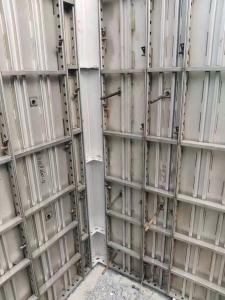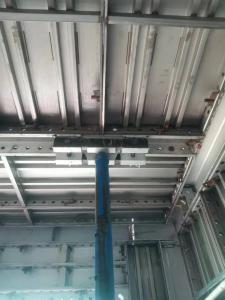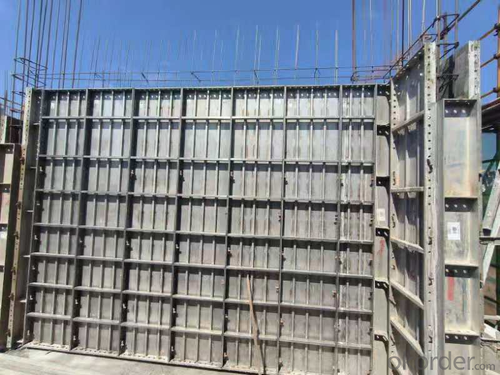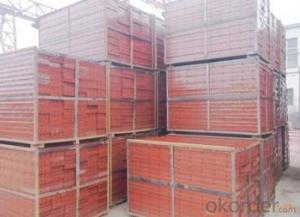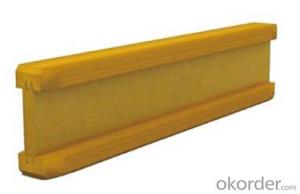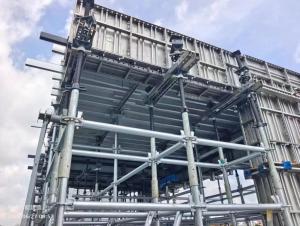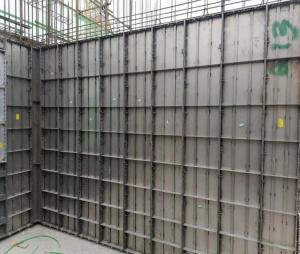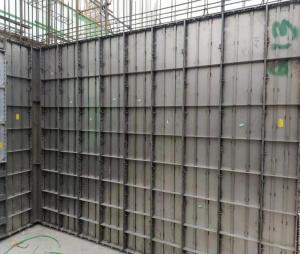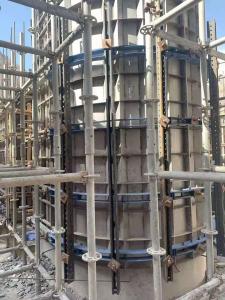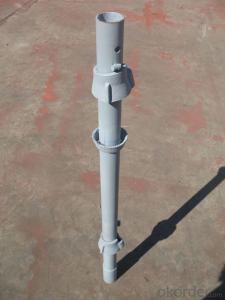High quality Support for concrete formwork Stainless Steel Formwork
- Loading Port:
- Shanghai
- Payment Terms:
- TT or LC
- Min Order Qty:
- 1 set
- Supply Capability:
- 1000000 set/month
OKorder Service Pledge
OKorder Financial Service
You Might Also Like
Replaceable size aluminum formwork :400X1200mm , 400X1500mm
Stainless steel formwork R&D background : committed to R&D and testing stainless steel formwork from material ,structure to processing technology for many years . Finally , a set of practical and lower cost perfect system has been developed .
Advantages:
1 Stainless steel formwork, 100% follow the design of aluminum alloy formwork system, it is interchangeable, compatible and can be used together with aluminum formwork at the same time .
2 (The maintenance of the floor or wall is simple and convenient, clean and smooth, easy to remove the mold, and the surface is beautiful.)
Integrated with the thermal insulation structure, the construction will be finished is fast, the efficiency is improved, no release agent is required, the wall has good flatness after de-moulding, no leveling is required, labor cost and time are saved . The construction speed of 5-6 floors a month shortens the construction period and saves Various expenses of the construction general contractor
3(The formwork is light in weight, loading capacity get higher , convenient in construction, high in strength, and stable in quality.)

- Q: How is steel formwork installed?
- Accurate and sturdy construction is ensured through the systematic and efficient installation of steel formwork. The typical process involves the following steps: 1. Careful planning and preparation are essential before steel formwork installation. This includes determining the desired shape and dimensions of the concrete structure, calculating the required amount of steel formwork panels and accessories, and ensuring the availability of all necessary tools and equipment. 2. Adequate site preparation is necessary. This involves clearing the construction site of debris and obstacles, leveling the ground, and establishing a solid foundation. 3. The positioning and alignment of steel formwork panels are carried out according to the planned structure. Various methods, such as clamps, nuts, bolts, or pins, are used to connect and secure the panels. Proper alignment and tightness are crucial to prevent concrete leakage or seepage. 4. If necessary, steel reinforcement bars are installed within the formwork to provide additional strength and support to the concrete structure. These reinforcement bars are precisely placed and firmly secured to the formwork panels in accordance with the structural design. 5. Adequate bracing of the formwork is essential to ensure stability and prevent deformation during concrete pouring and curing. Horizontal and vertical bracing systems are utilized to provide the necessary support and rigidity, evenly distributing the load and maintaining the desired shape of the structure. 6. Concrete is poured into the securely placed and braced steel formwork. Vibrators or other suitable equipment are used to compact the concrete, eliminating air bubbles and promoting proper adhesion and density. 7. After pouring and compacting the concrete, it must be cured to achieve maximum strength and durability. Curing can be done using various methods, such as covering the structure with plastic sheets or water spraying. Once the concrete has sufficiently cured, the steel formwork can be carefully removed, starting from the top and gradually moving downwards. It is important to note that the installation process may vary depending on project requirements, the complexity of the structure, and the type of steel formwork used. Therefore, it is advisable to consult experienced professionals or engineers to ensure proper installation and adherence to safety standards.
- Q: How does steel formwork prevent concrete spalling?
- By offering a robust and inflexible framework, steel formwork effectively prevents concrete spalling. This framework securely holds the concrete in place while it undergoes the curing process. When the concrete is poured into the steel formwork, it assumes the shape of the structure and gradually hardens. The steel formwork guarantees the concrete's stability, preventing any sagging or slumping that could result in uneven curing and subsequent cracking. Concrete spalling arises when the surface of the concrete begins to flake or chip away, thereby exposing the underlying layers. This deterioration can occur due to various factors, including moisture infiltration, freeze-thaw cycles, and chemical reactions. Steel formwork serves as a protective barrier against these external influences, effectively thwarting spalling. The snug fit of the steel formwork impedes water from permeating the concrete, thus reducing the risk of moisture-related spalling. In addition, this formwork acts as insulation against temperature fluctuations, thereby minimizing the detrimental effects of freeze-thaw cycles. These cycles transpire when water infiltrates the concrete, freezes, and expands, leading to cracks and spalling. By maintaining a consistent temperature, the steel formwork effectively averts these detrimental cycles. Furthermore, steel formwork acts as a shield against chemical reactions that can contribute to spalling. Certain chemicals, such as sulfates or chlorides, have the potential to react with the concrete, causing its structure to deteriorate and spalling to occur. The steel formwork serves as a physical barrier, preventing direct contact between these chemicals and the concrete, thus minimizing the risk of spalling. In summary, steel formwork plays a pivotal role in averting concrete spalling by providing a robust structure that supports the curing process and protects against moisture, temperature changes, and chemical reactions. Its strength and durability ensure the integrity of the concrete, mitigating the risk of spalling and prolonging the lifespan of the structure.
- Q: Are there any specific quality control measures for steel formwork installation?
- Yes, there are specific quality control measures for steel formwork installation. These measures typically include conducting thorough inspections of the formwork components, ensuring proper alignment and leveling, verifying accurate measurements, and assessing the overall structural integrity before concrete pouring. Additionally, regular monitoring and maintenance of the formwork during the construction process are essential to ensure its stability and durability. Adhering to industry standards and guidelines, such as those provided by the American Concrete Institute (ACI) or relevant local codes, is also crucial to ensure quality control in steel formwork installation.
- Q: Are there any specific considerations for using steel formwork in areas with high humidity?
- Indeed, when operating in regions with elevated humidity levels, specific precautions must be taken when employing steel formwork. This is due to the fact that high humidity can prompt an increased absorption of moisture by the steel formwork, ultimately leading to corrosion. In order to counteract this phenomenon, it is imperative to employ steel formwork that has undergone suitable treatment with anti-corrosion coatings or galvanized materials, which serve as a protective barrier against moisture. Furthermore, it is of utmost importance to consistently inspect and maintain the formwork in high humidity areas, as this will enable the identification of any indications of corrosion and facilitate the implementation of appropriate measures to impede its progression. Additionally, it is advisable to ensure adequate ventilation and airflow surrounding the formwork, as this will aid in reducing the humidity levels and minimizing moisture absorption.
- Q: What are the common design considerations for steel formwork in heritage buildings?
- Some common design considerations for steel formwork in heritage buildings include ensuring that the formwork is compatible with the existing architectural features and materials, preserving the historical integrity of the building, providing adequate structural support, and facilitating ease of installation and removal without causing damage to the heritage elements. Additionally, considerations for weather resistance, durability, and fire safety may also be important factors in the design process.
- Q: How does steel formwork handle different concrete finishing techniques?
- Steel formwork offers a wide range of possibilities for concrete finishing techniques due to its high versatility. It possesses great strength and durability, enabling it to withstand the pressure and forces exerted throughout various finishing procedures. When aiming for a smooth finish, steel formwork provides a solid and stable surface that facilitates easy pouring and leveling of the concrete. Its rigidity guarantees that the concrete remains in position and does not sag or deform during the finishing process. Consequently, the concrete can be smoothly troweled, resulting in a polished and uniform surface. Steel formwork is also suitable for textured finishes. It can be customized with different patterns and textures to create unique and decorative concrete surfaces. By utilizing specially designed steel formwork, such as those with corrugated or embossed patterns, the concrete can be poured to replicate these designs, resulting in visually appealing textured finishes. Furthermore, steel formwork is capable of accommodating exposed aggregate finishes. This technique involves removing the top layer of concrete to reveal the underlying aggregate stones, thus creating a decorative effect. Steel formwork can be designed with removable panels or inserts that allow the concrete to be poured in a way that exposes the desired amount of aggregate. After the concrete has cured, these removable panels can be easily taken off, revealing the desired exposed aggregate finish. Moreover, steel formwork is suitable for stamped concrete finishes. Stamped concrete involves imprinting patterns or textures onto the concrete surface using specialized stamps. Steel formwork provides a solid foundation for these stamps to be pressed onto, ensuring accurate and consistent imprints. The rigidity of steel formwork prevents the concrete from shifting or deforming during the stamping process, resulting in precise and high-quality stamped finishes. Overall, steel formwork is highly compatible with various concrete finishing techniques. Its strength, stability, and versatility make it an ideal choice for handling different finishing processes, allowing for the creation of smooth, textured, exposed aggregate, and stamped concrete finishes with precision and ease.
- Q: How does steel formwork affect the overall speed of construction?
- The numerous advantages of steel formwork greatly contribute to the overall speed of construction. Firstly, its high durability ensures that it can withstand the pressure of concrete pouring without any deformation or damage. This durability allows for multiple reuses of the formwork, eliminating the need for constant replacement with new materials and saving both time and cost. Furthermore, steel formwork provides a smooth and even surface finish, which reduces the time needed for additional plastering or finishing work. This smooth finish also guarantees accurate alignment of structural elements, resulting in faster and more efficient construction. In addition, the ease of assembly and disassembly of steel formwork facilitates quick installation and removal. This user-friendly feature eliminates the need for extensive labor and minimizes the time required for formwork setup, ultimately accelerating the construction process. Moreover, steel formwork is highly adaptable and can be used in various types of building structures. Its flexibility allows for customization and efficient utilization in different construction projects, further enhancing the overall speed of construction. In conclusion, the utilization of steel formwork has a positive impact on the speed of construction by offering durability, a smooth finish, ease of assembly and disassembly, and adaptability. These advantages result in time and cost savings, efficient construction processes, and ultimately faster project completion.
- Q: How does steel formwork affect the cost of construction?
- The overall cost of construction can be significantly influenced by steel formwork. Despite the need for a greater initial investment compared to traditional formwork materials like wood or plywood, steel formwork offers several advantages that can help counterbalance the increased cost. To begin with, steel formwork is highly durable and long-lasting, enabling it to be reused multiple times. Unlike wood or plywood formwork, steel formwork does not warp, rot, or deteriorate over time. This ability to be reused reduces the necessity for frequent formwork replacements, resulting in material cost savings in the long term. Moreover, steel formwork provides exceptional strength and stability, allowing for the construction of intricate and high-quality concrete structures. This strength permits the usage of thinner formwork elements, reducing the overall weight of the formwork system. Consequently, less labor and equipment are required for handling and installation, resulting in cost savings in terms of manpower and machinery. Furthermore, steel formwork facilitates faster construction cycles. The smooth and precise surface finish provided by steel formwork diminishes the need for extensive finishing work. This streamlined construction process saves time, ultimately reducing labor costs and project timelines. Additionally, steel formwork enhances safety on construction sites. Its robust nature and secure connections guarantee stability during concrete pouring and curing, minimizing the risk of accidents or structural failures. This improved safety aspect can help decrease insurance costs and potential legal liabilities. Lastly, steel formwork is highly adaptable and customizable. It can be easily modified and adjusted to accommodate various design requirements, making it suitable for a wide range of construction projects. This flexibility optimizes material usage and ensures minimal wastage, thereby reducing overall construction costs. In conclusion, although steel formwork may initially incur a higher cost, its long-term benefits such as reusability, strength, speed, safety, and adaptability contribute to overall cost savings in construction projects. Its durability and efficiency make it a cost-effective choice that can positively impact the quality, timeline, and budget of any construction undertaking.
- Q: What are the common design considerations for steel formwork in high-rise buildings?
- When designing steel formwork for high-rise buildings, there are several important factors to consider. These considerations are crucial for ensuring that the formwork system is structurally sound, safe, and efficient. 1. Load capacity is a key consideration. The formwork must be able to withstand the weight of the concrete, workers, equipment, and other loads without deforming or failing. 2. Stability is also important. High-rise buildings are exposed to external forces like wind and seismic loads, so the formwork system must be stable and resistant to these forces. Proper bracing, tie-downs, and anchorage systems should be included in the design. 3. Durability is essential due to the harsh conditions of construction sites. The steel formwork must be able to withstand moisture, chemicals, and physical impact. Material selection and protective coatings should be carefully chosen to prevent corrosion and ensure long-term durability. 4. Flexibility is necessary because high-rise buildings often have complex geometries. The formwork system should be able to accommodate different floor layouts, wall configurations, and column sizes. Modular formwork systems are commonly used for their flexibility and ease of adjustment. 5. Safety is of utmost importance in high-rise construction. The formwork system should include safety features like non-slip surfaces, guardrails, access platforms, and fall protection systems. Sufficient space for workers to move around and perform their tasks safely should also be considered. 6. Construction timeline is a critical factor. The formwork system should be designed for fast and efficient construction, minimizing downtime and delays. This could involve using pre-fabricated components, easy assembly and disassembly methods, and efficient material handling systems. 7. Cost-effectiveness is another consideration. The design should optimize cost-effectiveness without compromising quality and safety. This includes factors like material selection, formwork reuse, efficient labor usage, and waste reduction. In summary, the design considerations for steel formwork in high-rise buildings revolve around load capacity, stability, durability, flexibility, safety, construction timeline, and cost-effectiveness. By carefully addressing these considerations, designers can ensure a successful and efficient construction process for high-rise buildings.
- Q: What are the typical sheet thicknesses used in steel formwork panels?
- The typical sheet thicknesses used in steel formwork panels vary depending on the specific application and requirements, but they commonly range from 2mm to 6mm.
Send your message to us
High quality Support for concrete formwork Stainless Steel Formwork
- Loading Port:
- Shanghai
- Payment Terms:
- TT or LC
- Min Order Qty:
- 1 set
- Supply Capability:
- 1000000 set/month
OKorder Service Pledge
OKorder Financial Service
Similar products
Hot products
Hot Searches

